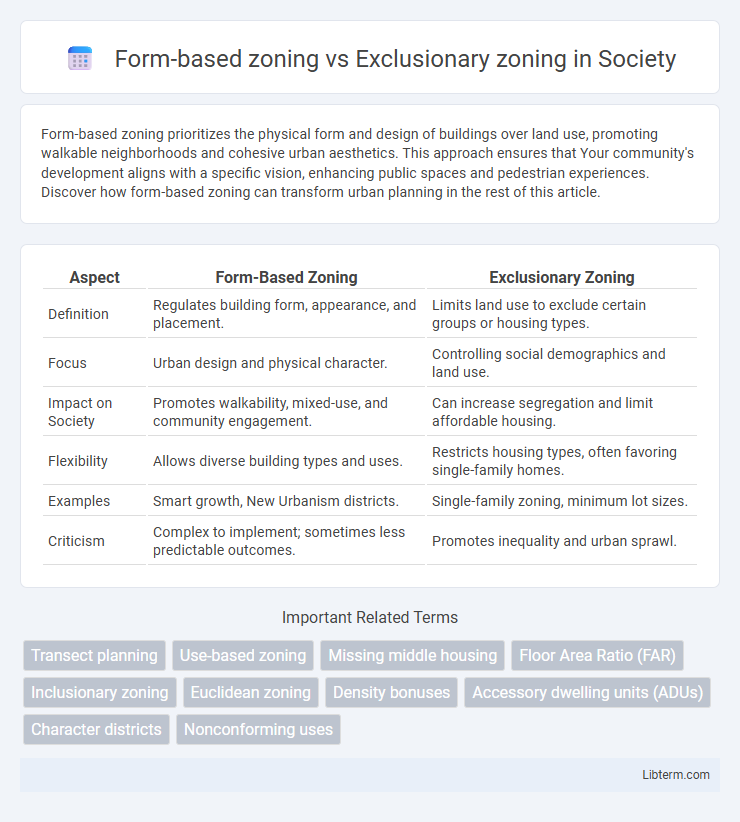Form-based zoning prioritizes the physical form and design of buildings over land use, promoting walkable neighborhoods and cohesive urban aesthetics. This approach ensures that Your community's development aligns with a specific vision, enhancing public spaces and pedestrian experiences. Discover how form-based zoning can transform urban planning in the rest of this article.
Table of Comparison
| Aspect | Form-Based Zoning | Exclusionary Zoning |
|---|---|---|
| Definition | Regulates building form, appearance, and placement. | Limits land use to exclude certain groups or housing types. |
| Focus | Urban design and physical character. | Controlling social demographics and land use. |
| Impact on Society | Promotes walkability, mixed-use, and community engagement. | Can increase segregation and limit affordable housing. |
| Flexibility | Allows diverse building types and uses. | Restricts housing types, often favoring single-family homes. |
| Examples | Smart growth, New Urbanism districts. | Single-family zoning, minimum lot sizes. |
| Criticism | Complex to implement; sometimes less predictable outcomes. | Promotes inequality and urban sprawl. |
Understanding Form-Based Zoning
Form-based zoning emphasizes physical form and urban design over land use, promoting walkable neighborhoods with mixed uses and predictable development patterns. This approach prioritizes building placement, street frontage, and public realm aesthetics to create cohesive, human-scaled environments. Unlike exclusionary zoning, which limits land uses to segregate and often restricts housing diversity, form-based zoning fosters inclusive, vibrant communities through clear standards tied to the built environment.
Key Principles of Exclusionary Zoning
Exclusionary zoning primarily relies on land use regulations that restrict certain types of housing, often through minimum lot sizes, limits on multi-family units, and prohibitions on affordable housing to control community composition. This zoning approach emphasizes separation by economic status or demographics, aiming to maintain property values and reduce perceived social risks. The key principles involve exclusion based on density, housing type restrictions, and stringent building codes that marginalize lower-income groups and hinder inclusive development.
Historical Context of Zoning Approaches
Form-based zoning emerged in the late 20th century as a response to the limitations of traditional exclusionary zoning, which was rooted in early 20th-century efforts to segregate land uses and maintain property values by restricting building types and densities. Exclusionary zoning initially aimed to separate residential, commercial, and industrial areas to reduce conflicts but often reinforced socio-economic and racial segregation. Form-based zoning prioritizes physical form and urban design standards to create mixed-use, walkable communities, reflecting a more contemporary focus on sustainable urban development and social inclusion.
Comparing Regulatory Frameworks
Form-based zoning emphasizes physical building form and community aesthetics through detailed design standards and public realm prescriptions, promoting walkability and mixed-use development. Exclusionary zoning relies on land use separation, often through minimum lot sizes and single-use districts, effectively limiting density and restricting affordable housing options. The regulatory framework of form-based zoning fosters diverse, pedestrian-oriented neighborhoods, while exclusionary zoning maintains rigid, segregated land uses with socio-economic barriers.
Impact on Housing Diversity
Form-based zoning promotes housing diversity by emphasizing architectural design, building form, and spatial relationships, enabling mixed-use developments and various housing types like townhouses, apartments, and single-family homes. Exclusionary zoning restricts housing diversity through regulations such as minimum lot sizes, single-family-only districts, and limiting multi-family units, which often reduce affordable housing options and maintain socioeconomic segregation. The shift to form-based zoning can enhance inclusive communities by supporting varied housing structures and densities.
Urban Design and Community Character
Form-based zoning emphasizes regulating building design, street layout, and public spaces to create cohesive urban environments that enhance walkability and aesthetic appeal. Exclusionary zoning restricts land use through measures such as large lot sizes or single-family housing mandates, often limiting diversity and hindering affordable housing development. Prioritizing form-based codes supports vibrant community character by fostering mixed-use neighborhoods and preserving architectural harmony.
Social Equity and Accessibility
Form-based zoning promotes social equity and accessibility by emphasizing physical form and mixed-use development that encourages walkability and diverse housing options, fostering inclusive communities. Exclusionary zoning often restricts density and housing types, leading to segregation and limited access to affordable housing and public amenities for marginalized groups. By prioritizing urban design and connectivity, form-based zoning enhances accessibility and reduces socioeconomic disparities compared to exclusionary zoning's tendency to reinforce spatial inequalities.
Economic Implications of Zoning Policies
Form-based zoning enhances economic development by promoting mixed-use neighborhoods and increasing property values through design standards that encourage walkability and aesthetic appeal. Exclusionary zoning restricts affordable housing options, limiting labor market access and perpetuating socioeconomic segregation, which can stifle local economic growth. Research shows that form-based zoning correlates with higher local business activity and increased resilience to economic downturns compared to exclusionary zoning's restrictive land-use policies.
Case Studies: Successes and Failures
Case studies reveal form-based zoning's success in places like Miami, where it enhanced urban design and walkability, contrasting with exclusionary zoning's failure in cities like Minneapolis, which faced litigation for discriminatory housing practices. In Seattle, form-based codes supported mixed-use development and affordable housing, whereas exclusionary zoning in suburban communities often led to socioeconomic segregation and limited housing diversity. These examples underscore form-based zoning's potential to create inclusive neighborhoods, while exclusionary zoning frequently perpetuates inequality and restricts urban growth.
Future Trends in Zoning Reform
Future trends in zoning reform emphasize a shift from exclusionary zoning, which restricts land uses through rigid regulations, toward form-based zoning that prioritizes physical form and urban design to create walkable, mixed-use communities. Cities adopting form-based codes aim to enhance urban livability, encourage affordable housing, and promote sustainable development by focusing on building form and public space rather than segregating land uses. Emerging reforms often integrate technology and community input to create adaptive zoning systems that respond dynamically to demographic changes and environmental challenges.
Form-based zoning Infographic

 libterm.com
libterm.com